#Elsa-Studie
Explore tagged Tumblr posts
Text
Im Emsland nichts Neues
Nach der sog. #Elsa_Studie gehört #Niedersachsen zum Mittelfeld bei der Versorgung von Schwangerschaftsabbrüchen. Doch manche Regionen stehen schlechter da. Prägnant titelt die taz: Im #Emsland nichts Neues.
Nach der Elsa-Studie gehört Niedersachsen zum Mittelfeld bei der Versorgung von Schwangerschaftsabbrüchen. Doch manche Regionen stehen schlechter da. Prägnant titelt die taz: Im Emsland nichts Neues. Sie berichtet: “Als vor einer Woche die Ergebnisse der Elsa-Studie zu Schwangerschaftsabbrüchen in einem sechsstündigen Video-Meeting vorgestellt wurden, saß Dagmar Wölk-Eilers zu Hause im Emsland…

View On WordPress
0 notes
Text
I came across kiss tutorials on Pinterest, I need to try them so it ended up in elsamaren doodles niarf niarf

#disney frozen#frozen#frozen 2#elsamaren#frozen elsa#disney#honeymaren#give elsa a girlfriend#frozen 3#lesbian#art study#artitst on tumblr#wlw ship#elsa x honeymaren#digital art#sapphic art#frozen fandom#frozen fanart#doodles
26 notes
·
View notes
Text

#re:zero#elsa grainhart#re:zero elsa#re zero#ive been spending the past 2 months grinding art studies and whatnot#and its super embarassing how this drawing gives away exactly what ive been focusing on specifically#haha#hahaha#well!
27 notes
·
View notes
Text






So, I was going to post this tomorrow, but the delightful bout of first snow today changed my mind! Milf Jacquie MILF JACQUIE MILF JACQUIE!!! But with a different flavor!
The idea of First-Born-Jacqueline-Gets-The-Curse has been my latest niche hyperfixation. I had WAY too much fun with this design session so I'm gonna word vomit under the cut ALL ABOUT this new snow queen for the new age
Just some general designy things:
Sketches! Straight from the sketchbook! The criteria I was given was her vibe leaning more towards Frostmas Jacqueline with a hint of Snow Queen.
But I personally wanted to see how much of a snow theme I could manage and how often id be able to keep her puffy sleeves! I don't know why that's Jacqueline's signature feature in my head, but it's the identifier I stuck with.
And when Milf Jacquie was first appearing there was talk of an ice collar and my first thought was that it seemed too villain coded for her. But in THIS AU where she really is the villain it's very fitting! Tried incorporating that in some places
And now some REALLY rapid-fire points on ALL the designs:
1) I wanted to try something REALLY different with her sleeves as a play on her default medieval style sleeves. And I tried keeping a lot more of her usual aged up details in this one (puff sleeve details, tall boots, eta.)
2) Accidentally more Elsa leaning than intended but mostly paying off of her usual icicle bodice in a different format.
3/4) Both of these are leaning heavily into the general Snow and Snow Queen vibe. And that HUGE fur collar on this and some others isn't actually fur! I'd like to think it's like super soft puffy snow.
5) This one is playing it REAL safe in the Frostmas territory, kinda like some of the Fem!Jack versions, as those also helped with designing her.
6) NOW THIS is a leather body suit just as a wild card just because I liked it! The gloves are giving vibes of this first frostmas piece from AGES ago
7) Were still playing around with sleeves and now mesh! It's probably up there as one of my personal favorites
8) Is very classic as I had to get a bare bones "suit" in there, but then I thought, "What if thigh highs?" And they probably should've been all one color, but thigh highs are a definite YES
9) Another personal fave, I decided to take Milf Jacquie's skirt, caplet thing and run with that concept into tailcoats! Give her an ice collar and the puff sleeves and she's ready to razzle dazzle!
10) Kinda a more "feminine" play on a normal suit but keep the concept of open legs from the last one and use frost as the lace!
11) This one accidently ended up more 60's inspired than I thought? It's reading more casual house wear, but all the vibes are still very there! The thigh highs strike again >:)
12) And the very last one is a different play on the pantsuit thing, with more frost to cover the titties but with incorporated gloves! Those little shits go alllll the way up its one whole thing!
This was a whole thing in the making for a WHILE but i guess I've just been really focused on Ice Fashion lol. Call me a goddamn fantasy designer, if anyone in Crystal Springs needs one hit me up!
#artists on tumblr#digital art#crystal springs#the final piece with her and Jack is a play on the Elsa concept art#she'd probably be so BITCHY but i love that for her#she deserves it#outfit studies
5 notes
·
View notes
Text
#frozen#Disney#Elsa#fanart#digital#art#procreate#sketches and studies#drawing#painting#art blogging#I love her
10 notes
·
View notes
Text
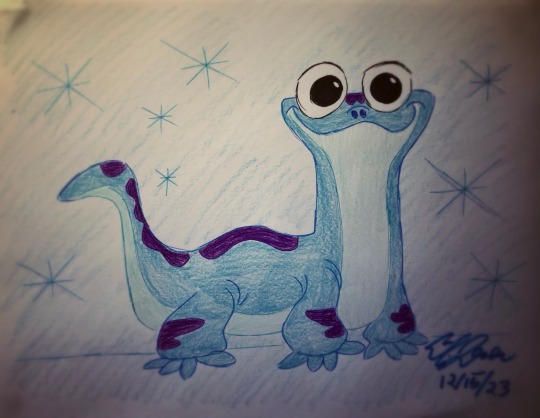
Bruni is cute!! ❄️❄️
#Bruni#Frozen 2#character study#Disney fanart#Disney 100#Christmas 2023#draw with Disney Animation#Elsa#Honeymaren#Olaf#the enchanted forest#Northuldra#Arendelle#salamander#fire spirit#fire#snow#ice
25 notes
·
View notes
Text

Elsa study. ❄️ The frosty lighting was actually pretty fun to do.
#elsa#elsa frozen#princess elsa#queen elsa#frozen#disney fanart#disney frozen#art study#digital art#illustration#art#digital illustration#disney#procreate#elsa fanart
81 notes
·
View notes
Note
Shoutout to that one time I had a dream about Wesker trying to infect Elsa from frozen with Uroboros WTF was happening there
HELP ME?????
13 notes
·
View notes
Text

REMEMBRANCE OF THINGS PAST: Elsa Varena as Isolde at the Landestheater Braunschweig in 1927. After she finished her stage career, Elsa Varena became a singing teacher. Her most important student was René Kollo.
#classical music#opera#music history#bel canto#composer#classical composer#aria#classical studies#maestro#chest voice#Elsa Varena#tristan und isolde#tristan and isolde#tristan and iseult#richard wagner#classical musician#cassical musicians#classical history#opera history#history of music#historian of music#musician#musicians#diva#prima donna
4 notes
·
View notes
Text
there is something so important to me about jane going from the title of "the mage" when she's a child, to becoming more akin to a witch when she's an adult. something about her having that mythical vibe, an air of mystery about her [specifically after closing the gate, and the physical scars it leaves on her neck + hands] and an overall magical presence. her powers and abilities becoming more natural rather than science based after she learns to control them in a way that makes her comfortable, rather than feeling forced. even when she loses them at sixteen, and lives without them for about ten years, she still has that spirit about her. if jane lived long enough, she would absolutely fall under the category of "green/woodland witch" [probably would've moved into a cottage in the woods somewhere fr just for that peace and quiet. because she was never made for the modern world y'know. she gave it her best shot, it was never meant to be!] presenting a hippie / bohemian aesthetic in terms of clothing, furnishings in her home, the way she physically moves and her overall perception of the world. she would get in touch with her spiritual side, practising things like tarot reading, cleansing rituals, and divination. not that she needs to physically have her powers at this point to practise these things and live that sort of life, but it helps her get in touch with her emotions properly, and really gets her down that cathartic path that no amount of therapy or "modern" techniques could truly achieve. she becomes soooo ethereal can u believe it!!
#† ) STUDY [ . . . ] come my darling homeward bound.#it's all about the growth y'know?#jane referring to her powers as 'abilities' when she's a kid.#but calling them 'powers' when she's older.#it's the symbolism!!#“if jane lived long enough” i say sadly. like i'm not the one who killed her off at 24.#i have a secret verse out there where jane lives a long life and becomes a witch in the woods. <3#uses her powers for minimal things. never has to use them for anything big.#never gets a nosebleed again bc there's no strain or pressure.#it's chill vibes all round.#think misty day from ahs tied in with sukkie from the witches of eastwick.#it's all just a GOOD VIBE.#i've also always compared her a bit to elsa from frozen. specifically with the song “show yourself”.#it's just the finding yourself side of things am i right!!!!!#thinking in this non-death verse.#she works in her shop until shes 28.#then sells up.#and moves out of hawkins FINALLY. get her out of there!!!#and idk where she moves yet. and idc if it's realistic or not.#but she moves into a cottage in the woods (think barbie diamond castle) and spends all day tending to her plants and doing witchy things#and living a quiet happy life. finally healing from everything.
5 notes
·
View notes
Text
November 14th is World Diabetes Day!
I'm someone who works with people affected by (mainly type 1) diabetes and I want to raise some awareness of positive things happening in 2023!
(Please note, I'm from the UK, so I'm biased to a UK perspective, and we are a bit behind some of the rest of the world...)
Best news is that the recent draft NICE guidance has recommended hybrid closed loop for people with type 1 diabetes. 🎉
Did you know that currently there are multiple hybrid closed loop insulin pumps on the market? These operate as close to the pancreas as we are currently able to mimic (a continuous glucose monitor measures interstitial fluid glucose and adjusts insulin delivery from a continuous subcutaneous insulin infusion pump - all the person has to do is tell it how many carbs they're eating, and the algorithm does the rest)
Have you heard about the ELSA study? This is screening for children happening right now in the UK to identify if they are at risk of developing type 1 diabetes. It requires only a simple finger stick blood glucose test and is open to every child aged 3 - 13, living in England, Scotland, Wales and Northern Ireland.
How about Ogluo? It's a newer form of glucagon that can be used like an EpiPen, which is a lot easier than the orange box for a panicking parent!
I'm going to reblog with some links to information about World Diabetes Day and charities that support research into diabetes (type 1 and type 2 and rarer types).
#diabetes#world diabetes day#type 1 diabetes#type 2 diabetes#elsa study#hybrid closed loop#disability#chronic illness
7 notes
·
View notes
Text
Okay but hear me out-

So after watching yet another rewrite of Wish I had an idea and MAYBE it sounds stupid-
But I want a 2d animated Disney movie about the cancelled/scrapped characters from Disney movies. I want the characters that got changed last minute or never even made it to their respective movie come together to figure out what the frick happened to them.
I want a character who is not rendered, with sketchy lines and unfinished parts, waking up on a blank page wondering what happened to their creator, and then spending the rest of the movie with the other unfinished characters looking for them to find out what happened. Each character drawn in different styles, some almost finished, some not, some missing an arm, some having the old lazy unwhitened eyes. All of them forgotten in the drafts.
I want the Emperor from the Kingdom of The sun, I want evil Elsa, and I want characters I wish Disney had made into stories a long time ago, my own favorite being Red Shoes that in my humble opinion NEEDS an adaptation!
Maybe they travel through the pages of the other Disney worlds unfamiliar with why they got their wish, but they didn't. Maybe it takes place in a whole other world of unfinished projects where dreams die but the characters live on- I JUST WANT THIS TO HAPPEN SOMEHOW.
#my artwork#disney#kingdom of the sun#evil elsa#original characters#movie idea#DISNEY ITS NOT THAT HARD#I should really stop procrastinating my studying why did I do this-
5 notes
·
View notes
Text
📌what does your heart look like?
iced over, out of the sun
your heart is very lonely, isn’t it? is your fortress of ice self-made? are others afraid of you, or are you afraid of them? are you afraid of hurting them, or of being hurt? vulnerability and connection can be frightening, but that’s no reason to shy away from their light, to tuck yourself small into corners, to build up frigid walls to keep yourself from feeling. you will heal when you allow yourself to draw closer to the flames and thaw.

tagged by: @phantombs ( always appreciated! ♥) tagging: @saeta, @eternl, @erabundus, @2minus, @nuidity, @farginen, @amoreemioo ( for hana ), @giventakes ( for stu ), @celestialshearts ( for luka ) , @indigodreames ( for tanawat ), @rippleofwords — or just steal and tag from me ☺
#( * 🔍 › character study )#what a callout post this result could not have been any louder#haru 🤝 elsa : self imposed kingdoms of isolation
10 notes
·
View notes
Text
Queerwolf By Night: Queercoding, Media Literacy, and Werewolf By Night (part 2)
Welcome back to Media Studies And Writing Hacks With Kat! Part 1 is here if you missed it. We discussed queercoding: what it is, how it works, why it exists, and how it plays into the 1930s and 40s horror movies Werewolf By Night likes to reference.
Once again, the thesis I'm arguing here is that there is queercoding in WBN, and that it should be part of the discussion of the special (which I'm calling a movie or film because I think "special presentation" is dumb and this is my essay.) I am NOT arguing that WBN is explicitly queer, or that inferring heterosexuality where queercoding exists is morally wrong or even textually inaccurate.
TL;DR: you can totally still ship Jack and Elsa, I just wanna point at some metaphorical rainbows and say, "Look! Rainbows! Aren't they neat?" I personally think the queercoding adds a layer of richness to the story. I hope you get something out of it, too.
And now, allow me to introduce our starting point, the wolfman of the hour, everyone's beloved blorbo and queercoded icon: Jack Russell.

Look at this adorable protagonist, this absolute chewtoy of a human being.
He's queercoded as fuck. Not as much as Ted, but we will GET to Ted.
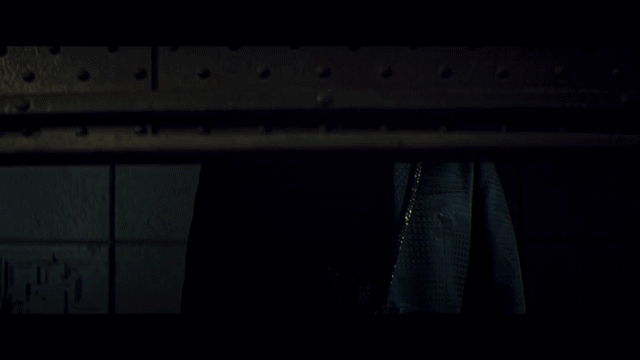
Let's begin with Jack's introduction, where he is literally revealed as the narrator speaks the phrase "the monster who finds himself among them". We join Jack as he enters an unknowingly hostile space, a building full of people who would literally mount his head on the wall if they knew who and what he really was. Jack's introduction to this world is a series of Bayeux-style tapestries showing, among other things, the gory slaughter of his kind. We see him react with a mixture of shock, queasiness, and tamped-down anxiety, which marks him as an outsider. It seems unlikely that the other hunters would be grossed out by the sight of a depiction of their literal jobs.
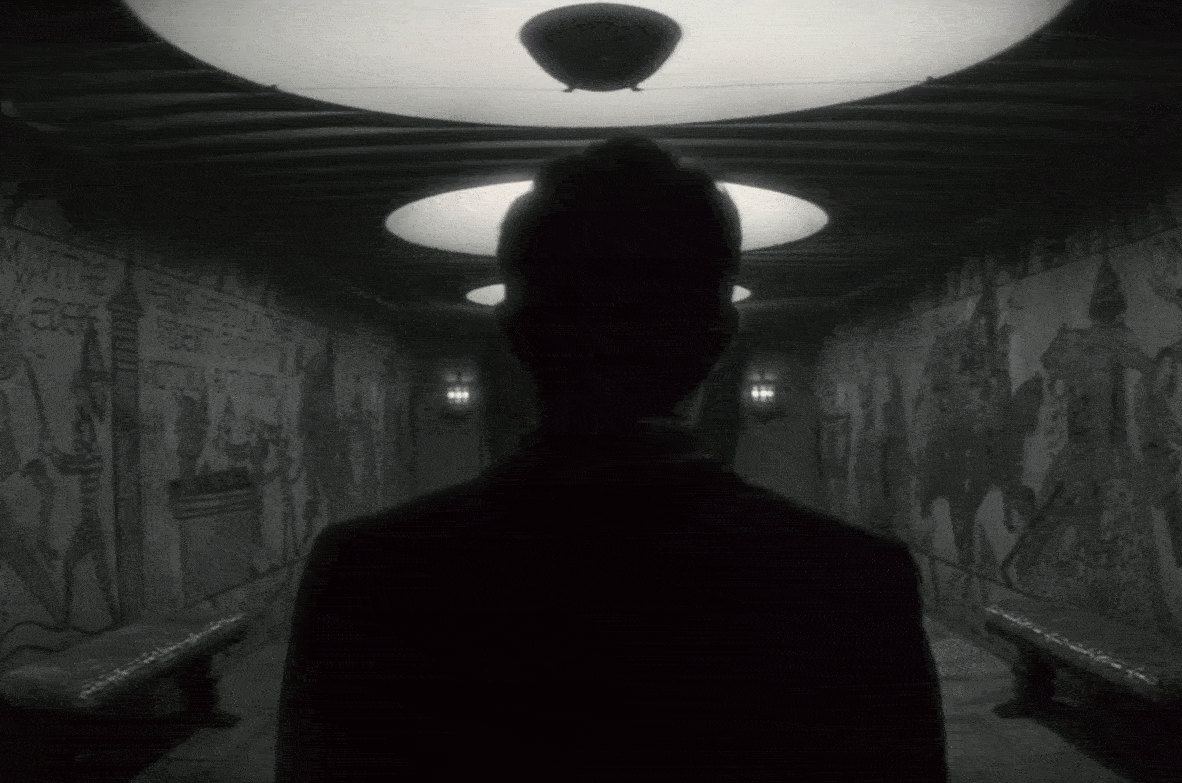
Now, outsider status alone isn't necessarily queercoding, but it often is, especially in monster movies. Jack's reaction is not dissimilar to that of a closeted person entering a homophobic church for some kind of socially expected ritual--and, indeed, Jack has come for a funeral.
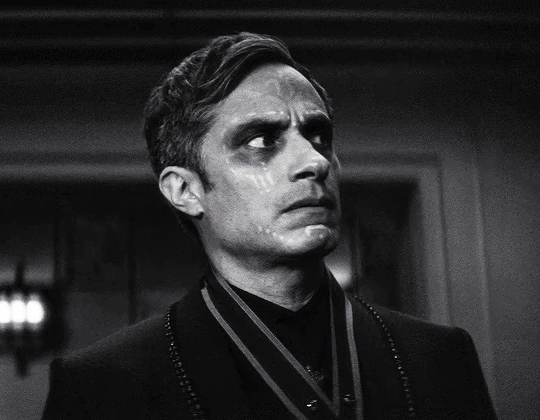
Look at that nervous glance as he walks into the room. He's not comfortable here. He knows he doesn't fit in.
This is a good time to mention Jack's outfit and the way it intersects with what we see of hunter culture. From the leather to the weapons to the heads on the wall, the aesthetic of hunter culture in WBN is hypermasculine, almost to the point of parody. The obsession with imagery of violence and death (the paintings on the walls, the corpse animatronic, the skull bowl) and the hostility to anything perceived as feminine is marked.
Wait. Hostility to anything feminine? Yes, I said that.
There are three characters who are played by female actors: Elsa, Verussa, and ... look, the hunters HAVE names, but I'm just gonna call them Scottish Guy, Asian Guy, Black Guy, and David Bowie. So David Bowie is an adrogynous character played by a female actor who acts as our third not-exactly-a-male character, and it's interesting to me that they're taken more seriously by the other hunters than Elsa is. Elsa, by contrast, is treated with contempt by the other hunters--and the contempt is very specifically gendered. Scottish Guy calls her "lassie" when he threatens her, and Asian Guy says, "Where's the lovely lady's medallion?" with a noticeable leer. They don't take her seriously, not even after Verussa announces she's welcome to participate--and they only brighten up when Verussa reminds them that they're allowed to kill Elsa if they can. That's the response to the only unambiguously female hunter.
Now, you may point out that Verussa doesn't get nearly as much shit from the hunters, but Verussa is explicitly presenting herself as the servant (and sexual partner) of a man. She's also not competing with them for the Bloodstone, nor trying to inherit, even though presumably she has at least as good a claim as Elsa does. She's not trying to enter the hypermasculine realm of hunting, but Elsa is in it, and so Elsa is despised and Verussa is tolerated.
And then there's Jack.
Okay, time for Baby's First Queercoding Element: gender nonconformity. In general, feminine male characters and masculine female characters (something explicitly forbidden by the Hays Code, by the way) are coded as queer. A lot of gay male stereotypes are men doing "womanly" things, like cooking and wearing dresses and having sex with men. The same goes for lesbian stereotypes like short haircuts, manual labor, and having sex with women. Now, obviously ACTUAL queer expression is infinitely more complex, but stereotypes don't do infinite complexity.
So. Is Jack feminine?
Well, he's wearing a gentleman's suit, but by the standards of hunter hypermasculinity, yeah, he's pretty girly. For one thing, he's wearing that suit in a room full of people in combat gear. For another, the suit itself is full of fussy details that mark him as a man who cares a great deal about his appearance, another stereotypically feminine trait. The suit is green, a barely acceptable color in menswear, and it has glittery details like the trim on his lapels. The spinal-column tie is metal as fuck, but it's also a silk tie. He's doing the death-and-gore theme, but making it high fashion. He's even wearing makeup. Granted, it's Día de los Muertos makeup, but it's still pigment on his face for aesthetic purposes. He's also the only hunter who acknowledges, in dialogue, that he has non-white, non-USAmerican heritage--"It's to honor my ancestors." He marks himself (literally) as visibly foreign, even though denigrating foreign masculinity is a big part of American hypermasculinity. He also tries to smile at and befriend every hunter who glares at him--another stereotypically feminine trait that leads to his conversation with Scottish Guy.
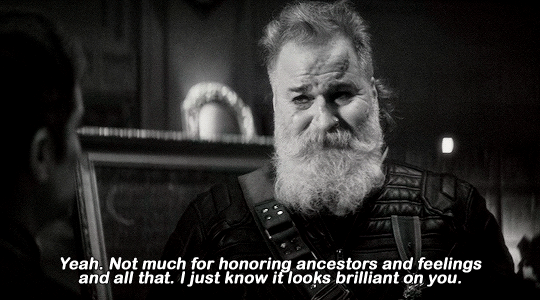
Speaking of, that conversation is gay as hell. It's practically flirting, especially the part where Scottish Guy compliments Jack's makeup and then tearfully admits that hunting and living all by himself "gets lonely". And Jack makes this amazing face:
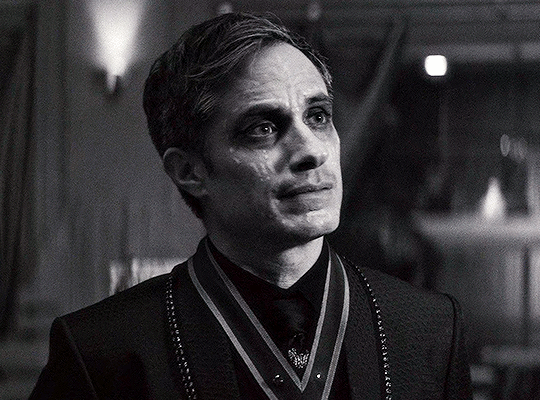
Now, this is me inferring again, but I read this face as a combination of "Aww, that's sweet of you" and "Loneliness caused by hypermasculine self-isolation? I literally have no idea what that's like, but it sounds bad, bro." Perhaps with a soupçon of "Get me out of this conversation aaaaaaa."
So the scene rolls on, and Jack continues to be Bad At Toxic Hypermasculinity. When his top kill count is mentioned, he shrugs it off rather than taking a little bow like the others do. He actually chuckles at Ulysses' joke. He seems mildly interested in Elsa rather than hostile, and amused by her snark rather than threatened by it. He shows fear and worry when he learns Ted is in peril and in pain. The guy really wears his heart on his impeccably tailored sleeve. Notably, none of these traits are bad, per se--they're just more likely to be assigned to feminine characters, and they're given to Jack.
It's important to note the impact of perspective here. Jack is our POV character. If there were to be a hunters' version of this story, Jack would be a sneaky, cowardly, vaguely effeminate villain and Elsa a traitor (or possibly a dimwitted victim seduced by Jack's charms). All of Jack's queercoding would make him a GREAT queercoded villain; it's just that here, he's the protagonist, and a deeply sympathetic one at that, so we miss some of his "unmanly" traits.
All right, let's fast-forward to the maze. We see Jack being clueless and awkward about the drawing of lots, we see some sneaking around, and then we see his first hostile encounter with Elsa, and we get this great exchange:
Jack: I suggest we just pass each other by.
Elsa: ... What?!
Jack, visibly pained by the awkwardness: I suggest we just ... pass each other by.
Jack is uncomfortable with violence. He actively avoids it, talking his way out of trouble when he can and running when he can't. Even Elsa points out how strange he is compared to other hunters, specifically because he avoids violence. He doesn't kill or even hurt anyone in his human form. He doesn't even know how his explosive works--to the point where he asks a woman if SHE knows how to work it.
I'm not saying violence is an inherently masculine trait, but the association of masculinity with a capacity for (and comfort with) violence runs deep in Western culture in general and American culture in particular. It's a huge thing in Mexican culture as well, and yet Jack is actively choosing not to participate in it. He's denying a core part of what would otherwise be his traditional gender role. He later tells Elsa that any "hunting" he does is done by "a part of me that is not me"--a part of himself that he doesn't see as himself. In his eyes, violence is not merely scary or distasteful; it's not part of him at all.
(Compare this to all the ass-kicking Elsa does.)
And then we get to Ted. Buckle up, guys.
Technically, our first introduction to Ted is a distant roar and some screaming, but the moment where we meet him is this:

A jumpscare, followed by a cuddle.

Once again, Jack wears his heart on his sleeve, but more importantly, let me draw your attention to the juxtaposition of Ted's scary grab and Jack's excited snuggling. This relationship is introduced as something scary before being revealed as something sweet--and "scary" is a good description of the portrayal of queercoded couples (who are, remember, usually villains) in classic cinema. All the cinematic language around Ted right up until the grab is telling us to be afraid of him--and then our cinnamon roll of a protagonist starts petting him and greeting him and asking if he's okay. Ted is monstrous and inhuman ... right up until we see him receive affection from another man.
We don't get clear details of Jack's relationship with Ted, but we know that it's a big deal to them--after all, Jack is risking his own life to save the big guy. Jack also describes Ted as "family" and, with a fond eyeroll, a "pain in the ass". Jack implies that he no longer has contact with his family of origin, a common experience for many queer people who are shunned for leaving the closet, but Ted slots neatly into the category of found family. Ted is also, notably, the only close relationship Jack is seen to have, just as Jack is the only close connection Ted is seen to have. The two are physically affectionate (again, cuddling) and emotionally vulnerable in their conversations.
And Elsa, the outsider to their relationship, finds the whole thing bizarre, right down to Ted's name.
Speaking of Elsa, let's talk about Jack's behavior in the crypt and the cage.
In the crypt, Jack displays compassion for someone who has largely been hostile to him (he REALLY wants to fix Elsa's leg), absolute delight when he receives the tiniest signal that she might be sympathetic to him ("It's not in your DNA, then?") and remarkable emotional intelligence (see his speech about families). He also, notably, doesn't hit on Elsa or indicate any sexual interest in her.
He also makes this terrific face when he's handed a skull:
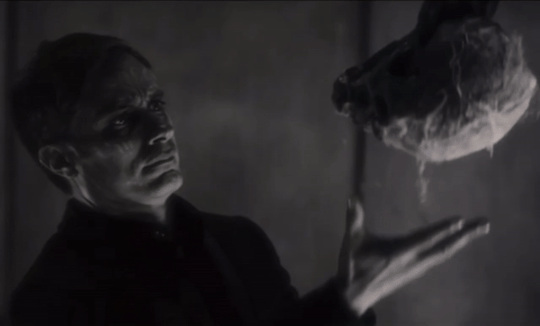
Oh, yeah, that's a big, scary hunter there.
Now, the cage. Jack's response to being put in the cage (and stripped of his jacket, interestingly--little bit of dehumanization there, perhaps) is recognition, followed by attempts at reassuring Elsa, followed by panic. He's arguably more upset than Elsa is, and Elsa thinks she's about to be torn to shreds.
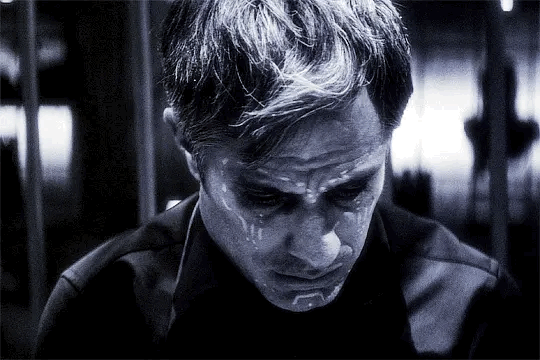
At two points in this story, Jack Russell finds himself trapped in a small space with a beautiful woman and more or less immediately freaks out. It's not the most heterosexual pattern. In fact, it's got strong thematic overtones of queer men being forced into straight relationships by their families, their work, or their society. In a culture that entwines sex and violence, the fact that he's delighted to be grabbed by a male swamp monster but begs for death rather than symbolically do a sex with a woman is noteworthy.
"Symbolically do a sex"? Yeah, the only times the film frames Elsa as anything like a sexual object are the transformation sequence, which is a visual callback to classic sexualized scream queens of yore with her literally in Jack's shadow, and the face-touching scene, where Jack straddles her, their faces almost touch, and then he flees and she sits up with her hair mussed in a dreamy, almost post-orgasmic way.
Michael Giacchino doesn't eroticize violence MUCH, but he's fairly classy about it when he does.
"But wait!" I hear you saying. "What about the sniffing scene? Isn't that eroticized? And it's between Jack and Elsa! Checkmate, liberals!"
First of all, how dare you call me a liberal when my preferred political descriptor is "chaotic good". And second of all ... well, you're HALF right. It IS eroticized...but not because of anything Laura Donnelly or Gael Garcia Bernal is directly doing.
Go watch Elsa's body language during the scene. It's awkward as fuck. She's curled in a ball, knees and elbows out, letting Jack pull on her arm and sniff her hair but not really participating. There's no indication that she wants to be doing this, or even knows what "this" is.
Gael is making a little more of an erotic show about it; in fact, the intensity of his sniffing would probably be an indicator of sexual desire--if he weren't CRYING WHILE HE DOES IT. That's why his voice breaks on "Once."
These are both excellent actors, making very intentional choices with their voices and bodies. They're playing the scene as something that COULD be sexy IF THEY WEREN'T BEING FORCED TO DO IT.
Seriously. There's enough fanfic now that we've all read Jack giving Elsa a leisurely, consensual sniff. You can't tell me Gael and Laura couldn't have made that happen. This is not sexy sniffing. This is angst sniffing. It's just angst sniffing between two beautiful, sympathetic characters who genuinely don't want to hurt each other. It could have been acted and shot in a much sexier way, but it wasn't.
It's also worth noting one last category of queercoding that WBN plays with a lot: dehumanization. A lot of those classic movies played their queercoded characters as specifically less than human, visually aligning them with disliked animals like rats or wolves and often making them literally less human as the story progressed. Even after the Hays Code, monstrous and inhuman queers became a staple of horror movies, especially in the 1980s and 90s as the AIDS crisis convinced a lot of conservative America that LGBTQ people were literal plague rats. There were proposals to tattoo HIV-positive people to identify them, to round them up into camps, to shut HIV-positive kids out of schools because those kids were implicitly queer and therefore not deserving of human rights like an education.
WBN, with its werewolf POV, pushes back on this trope in some specific ways. Jack's line about being "still a human" is an obvious one, as well as his explanation of "systems" to keep other people safe. (It was common during the AIDS crisis for queer people to be fired from their jobs if they were outed because they were considered an AIDS risk to their coworkers--even if they were, say, an office worker who didn't have any contact with other people's bodily fluids. There were conspiracy theories about AIDS spreading through shared soda cans. Those paper seat protectors in public bathrooms came about because of fears that AIDS could spread via toilet seats. So imagine a gay man trying to explain that he's not a threat to his officemates, and you'll see the parallels to Jack trying to reassure Elsa.)
Most notable, however, is how Elsa survives the wolf. She's safe because she maintains eye contact (implicitly acknowledging her and Jack's shared humanity--she literally refuses to stop seeing him) and because he remembers her scent (she becomes a part of his world as he becomes part of hers). Elsa is rewarded, both with her life and with her inheritance, for treating Jack and Ted like human beings when the world around her regards them as abominations.
Elsa is an ally. She's ally-coded. She can also be read as a love interest for Jack, but she consistently acts in support of his relationship with Ted as well.
In Part 3, we're going to talk about the crowning moment of queercoding in WBN. That's right--it's time to learn about coffee in the woods, the gay jukebox, and the Friends of Dorothy.
#werewolf by night#werewolf by night meta#queer coding#jack russell#ted sallis#elsa bloodstone#attempts at formal analysis#what am i even doing#i hope someone actually likes this#jfc this is so much longer than i planned#nobody get mad at me please#i am literally just pointing at the thing we all like and saying “look a good bit”#long post#media studies and writing hacks with kat
24 notes
·
View notes
Text
ivy by taylor swift is so elsabela coded.
#elsabela#isabelsa#i listened to evermore while studying for my sociology test and i thought about it. like damn. ivy is elsabela#elsa x isabela
9 notes
·
View notes
Photo
what the fuck just happened


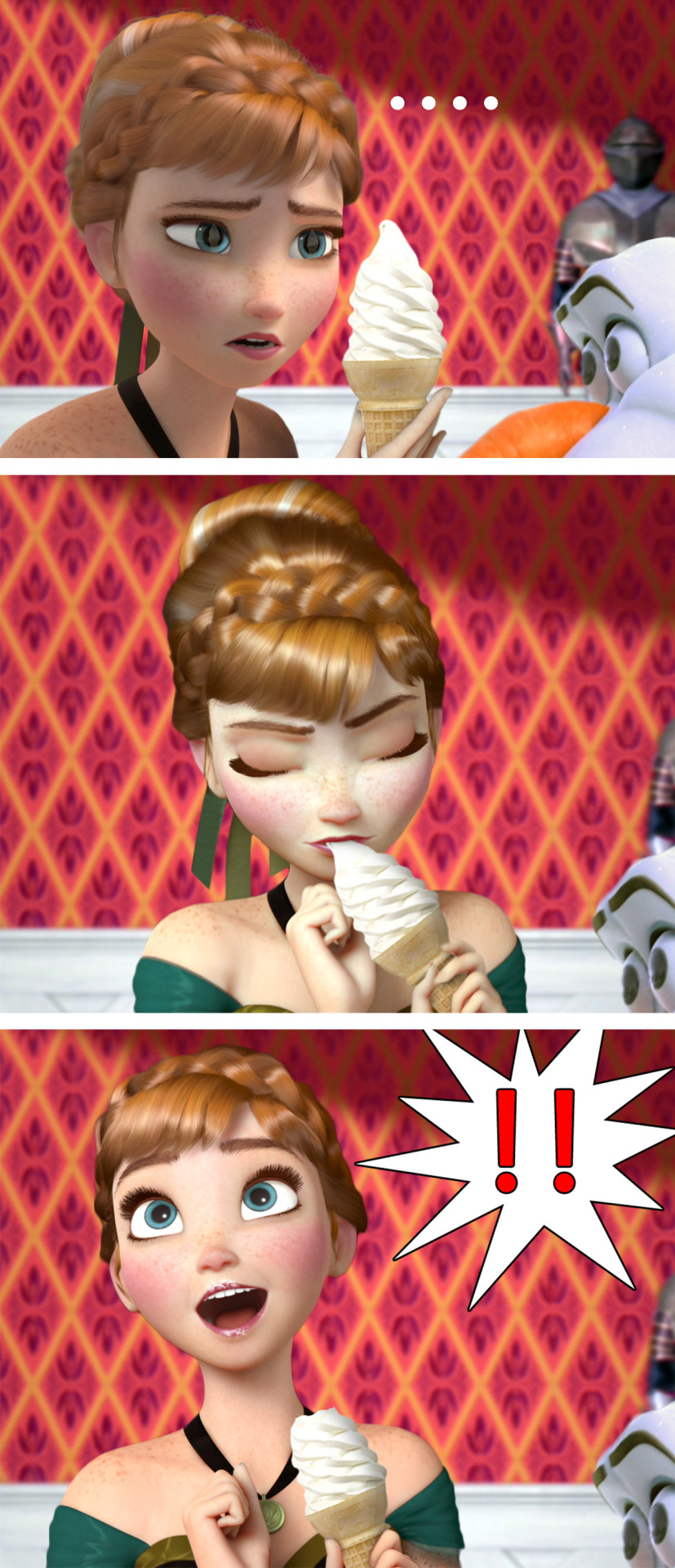

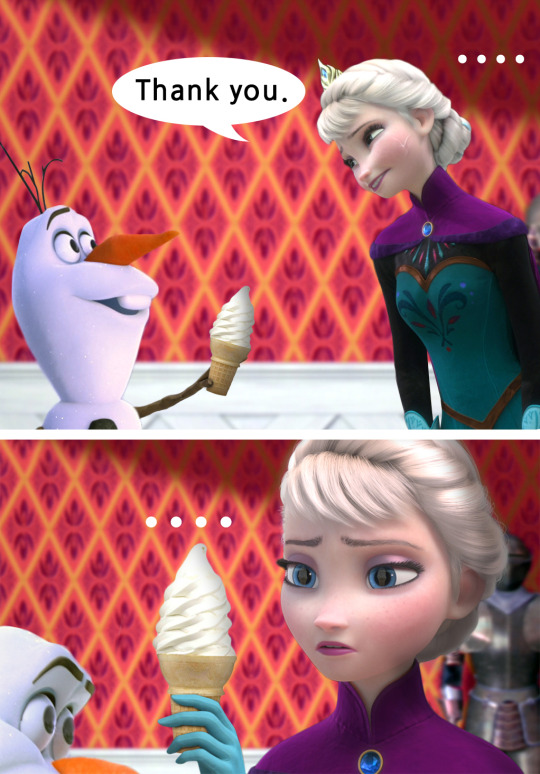




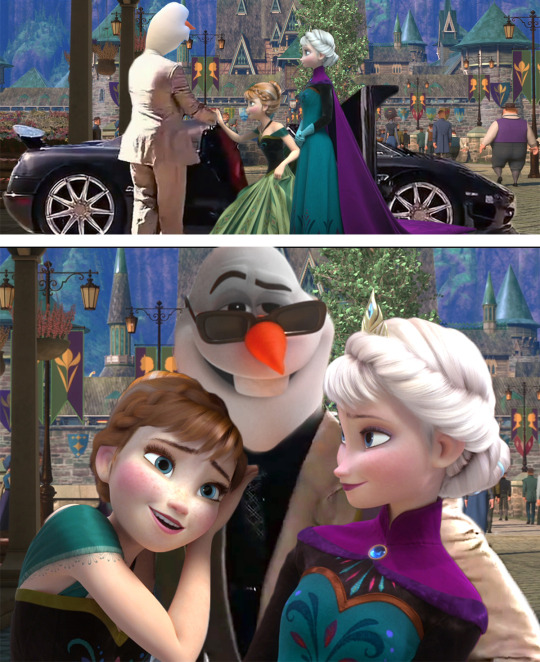
olaf.
#frozen#elsa#anna#olaf#wtf#I love frozen#the first movie though not the second#my first crushes were Elsa and calliou for some reason#also maybe doc mcstuffin#no wait I didn't like caliou I wanted to be his friend#his parents seemed rich after#*asf#jeez now the theme song is in my head#you know what had good music?#lazy town#oh how I love lazy town#the first thing I every studied for was when my shows would come on#I had memorized it and made my parents watch as well#and when I found frozen I was even worst#oh yeah this was about frozen#I these are the fucking tags#well shit#sorry for the random tag#*tags#alot of tags
537K notes
·
View notes